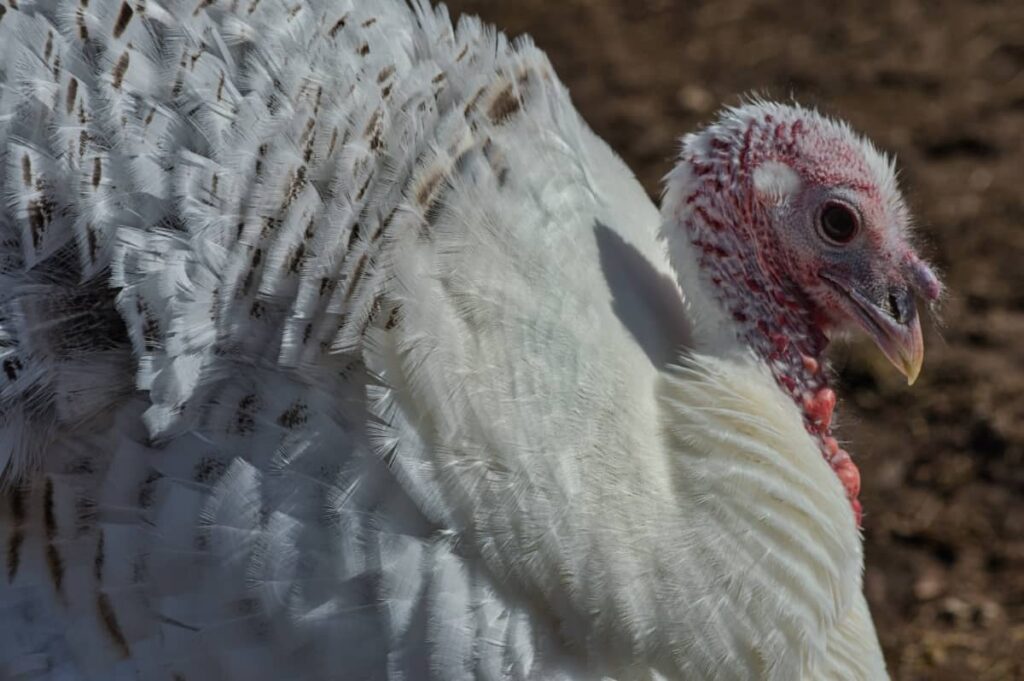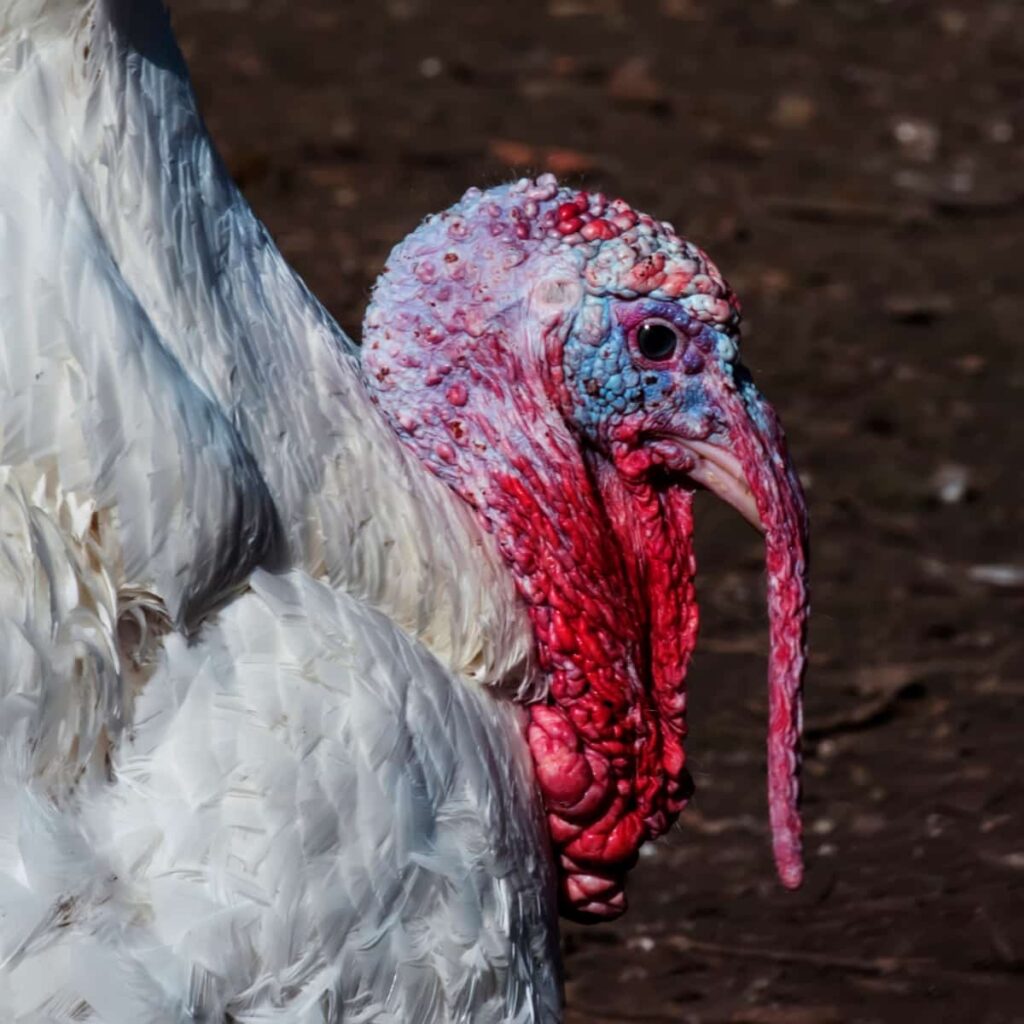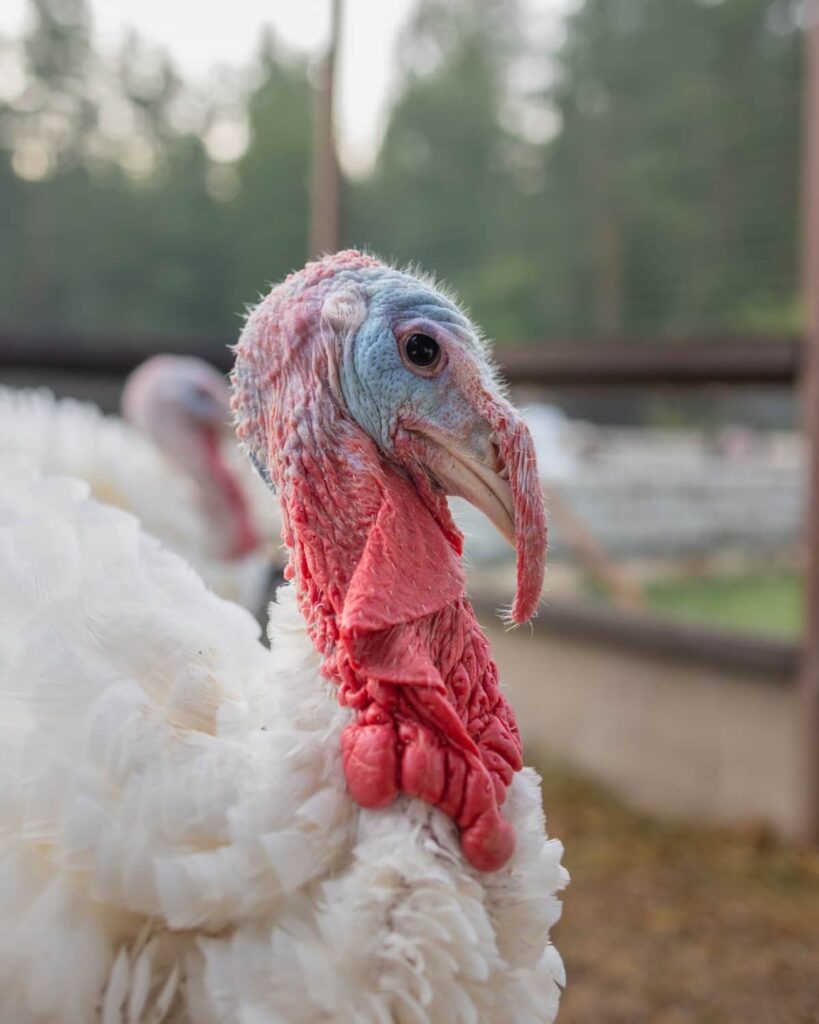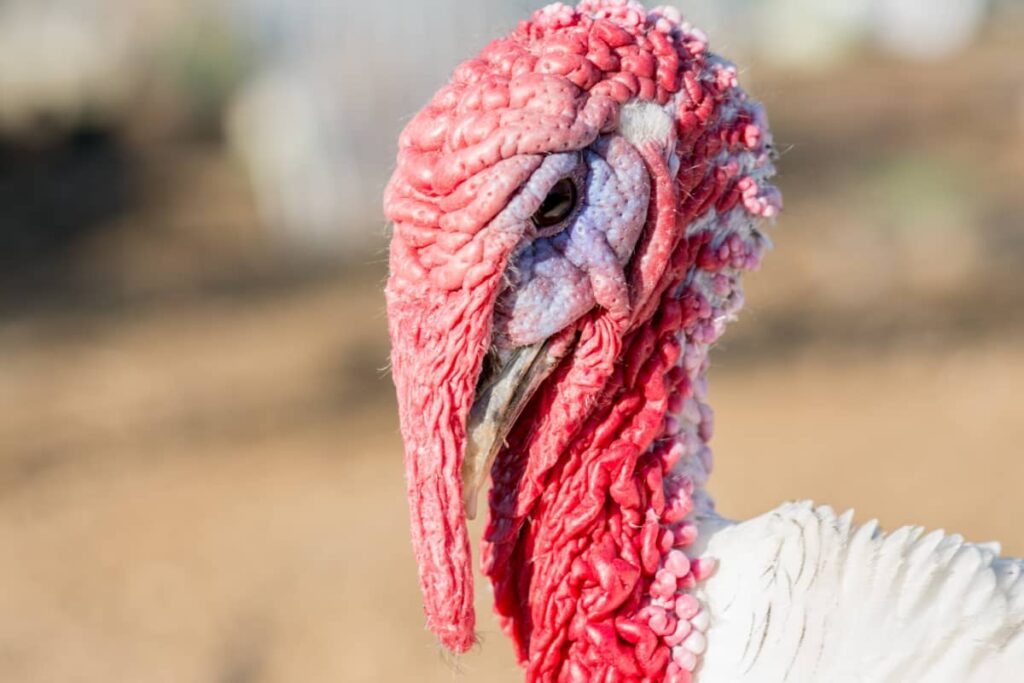The Broad Breasted White is commercially the most widely used breed of domesticated turkey. Raising the Broad Breasted White Turkey breed comes with several benefits that make it an attractive choice for many farmers and homesteaders. This particular breed has gained popularity and widespread adoption due to its exceptional meat qualities.

Broad Breasted White Turkey
Characteristics
The Broad Breasted White turkey breed is known for its distinct characteristics that set it apart from other turkey breeds. One of the most noticeable features of this breed is its size. Broad Breasted Whites are also recognized for their white plumage, which gives them a clean and elegant appearance. This color makes them easily distinguishable and adds to their overall appeal.
These turkeys are known for being docile and calm. Broad Breasted Whites have been selectively bred over generations to develop traits that make them ideal for meat production. Their broad breast muscles contribute to their high meat yield, making them the preferred choice for commercial turkey farming.
Broad Breasted White Turkey Profile
| Breed Name | Broad Breasted White Turkey |
| Place of Origin | United States |
| Uses | Meat |
| Tom (Male) Size | 30-40+ pounds |
| Hen (Female) Size | 14-20 pounds |
| Color | White |
| Lifespan | 2-5 years |
| Climate Tolerance | Hot and cold climates |
| Care Level | Minimal |
| Temperament | Docile |
| Rarity | Common |
Temperament
Known for their docile nature and friendly disposition, these turkeys are a joy to have around. They are known to be quite friendly with humans, which makes handling them much easier. Unlike some other breeds that can be aggressive, it is generally very approachable and even-tempered. Their amiable temperament also extends to their interactions with other animals on the farm. These turkeys tend to get along well with chickens, ducks, and even goats or pigs if they share living spaces. This makes integration into existing livestock systems relatively smooth.
Origin and History
It has an origin story that dates back to the early 20th century. This breed was developed in the United States through careful breeding programs aimed at creating a larger, more meaty turkey for commercial purposes. The exact details of its creation are not well-documented, but it is believed that the Broad Breasted White emerged as a result of crossbreeding between various European turkey breeds and native American turkeys.
In case you missed it: Turkey Farming Information For Beginners

Over time, the Broad Breasted White became increasingly popular among farmers and consumers alike due to its impressive size and succulent meat. Today, this breed dominates the commercial turkey industry in North America and beyond. Its widespread popularity can be attributed to the high yield of white breast meat – qualities that make it ideal for large-scale production.
Size and Weight
These turkeys have been selectively bred for their large size, making them an ideal choice for those looking to raise turkeys for meat production. The Broad Breasted White Tom (male) can reach an impressive weight of 30-40+ pounds, while the hen (female) usually weighs between 14-20 pounds. Their substantial size is a result of years of careful breeding, focusing on traits like fast growth and efficient feed conversion. This makes them an excellent choice for commercial turkey farming as they provide a higher yield of meat compared to other breeds.
Uses
The Broad Breasted White turkey breed is primarily raised for its meat. With a large size and high muscle yield, it is highly sought after by farmers and consumers alike. The meat of the Broad Breasted White turkey is known for being tender, juicy, and flavorful, making it perfect for holiday feasts or special occasions. Additionally, this breed can also be used as a show bird in poultry exhibitions.
Its striking white plumage and impressive size make it a standout among other breeds. Another potential use for this breed is as a breeding stock to produce hybrid turkeys with desired characteristics. Some individuals may choose to raise the Broad Breasted White turkey simply as a pet or companion on their farm or property. These turkeys have a docile temperament and can become quite friendly with regular interaction from their owners.
Price Range
In general, Broad Breasted White Turkeys tend to be more expensive compared to other turkey breeds due to their size and meat quality. As they are primarily raised for their meat production, they command a higher price in the market. The price range for a live Broad Breasted White Turkey can typically start at around $50 and go up from there. However, make sure that prices may fluctuate based on factors like age, weight, and breeder reputation.
Lifespan
These turkeys have a relatively short lifespan compared to other turkey breeds, typically living between 2 to 5 years. While this may seem like a shorter lifespan compared to some other animals, it’s important to remember that the primary purpose of raising Broad Breasted Whites is for their meat. These birds are specifically bred to grow quickly and reach a marketable weight in a short amount of time.
In case you missed it: Bronze Turkey Breed: Profile, Characteristics, Origin, Size, Uses, Price, Breeding, and Lifespan

However, with proper care and management practices, you can help ensure that your Broad Breasted Whites live healthy lives during their relatively short span. Providing turkeys with a balanced diet, regular exercise opportunities, clean living conditions, and access to fresh water will greatly contribute to their well-being.
Care and Management
Providing them with a suitable living environment is essential. These turkeys need ample space to move around and stretch their wings, so a spacious pen or pasture is ideal. Ensuring that they have access to clean water is crucial for their overall health. Regularly checking the water source and cleaning any containers or troughs will help prevent contamination and disease. Feeding these turkeys by using a balanced diet is also important. They require high-quality poultry feed that meets their nutritional needs.
A professional should conduct regular health checks to identify any potential issues early on. This includes monitoring for signs of parasites, respiratory problems, or other common ailments that can affect turkeys. Creating a stress-free environment can greatly benefit the overall management of your Broad Breasted White Turkeys. Minimizing loud noises, sudden movements, and unnecessary disturbances will help keep them calm and content.
Breeding and Reproduction
To ensure a successful breeding program, it is important to select healthy and genetically diverse birds from reputable breeders. The breeding season for turkeys typically begins in the spring when the hens start laying eggs. During this time, it is crucial to provide optimal conditions for mating. Once mating occurs, the hen will lay a clutch of eggs over several weeks. It is recommended to collect these eggs daily to prevent any damage or breakages.
If you wish to hatch your turkey chicks, you can incubate the fertilized eggs or allow a broody hen to do so naturally. Incubation usually takes around 28 days, during which constant monitoring of temperature levels is necessary for successful hatching. Once the poults (baby turkeys) hatch, they require warmth, food, water, and proper care until they mature into adult birds. Breeding plays a vital role in maintaining healthy populations of Broad Breasted White turkeys.
In case you missed it: White Holland Turkey Breed: Characteristics, Origin, Size, Uses, Price, Breeding, and Lifespan

Conclusion
Raising the Broad Breasted White Turkey Breed holds immense importance for farmers and homesteaders alike. This breed is specifically bred for its meat production, making it a lucrative choice for those in the poultry industry.
- Crops Grown in Summer Season: Best Choices for Summer Gardening
- Organic Pest Control for Tomato Farming
- How to Maximize Sheep Farming Profit
- Broccoli Varieties: Choosing the Right Cultivars for Your Farm
- How to Raise Pigs in Your Own Backyard: A Comprehensive Guide
- Budget Friendly Sheep Shed Ideas: Cheap and Low-Cost Tips
- How Much Do Cattle Farmers Make: Revenue Streams in Cattle Farming
- Management Pests and Diseases in Your Cotton Field
- Sheep Farming Business Plan for Beginners
